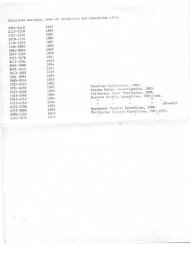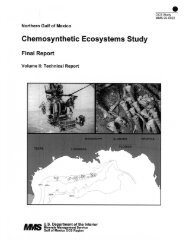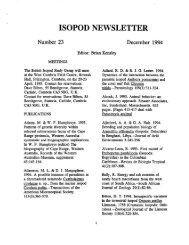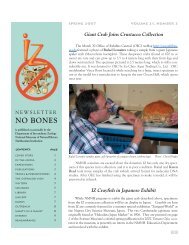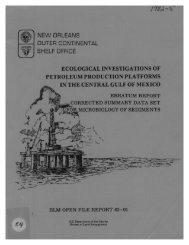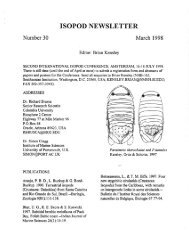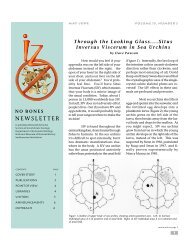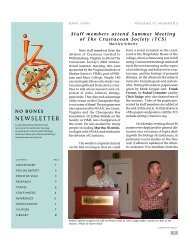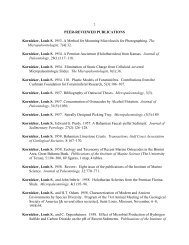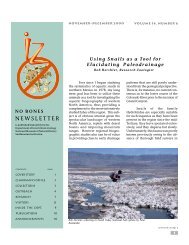Executive Summary - Department of Invertebrate Zoology
Executive Summary - Department of Invertebrate Zoology
Executive Summary - Department of Invertebrate Zoology
Create successful ePaper yourself
Turn your PDF publications into a flip-book with our unique Google optimized e-Paper software.
analyzed for leachable metals and USGS total digestates were analyzed<br />
for barium and vanadium . During the second year VIMS analyzed<br />
sediments for both leachable and total metal concentrations .<br />
VIMS collected suspended sediments for USGS analysis and, using a<br />
USGS instrument, provided USGS with records <strong>of</strong> nephelo aeter/<br />
transmissometer traces .<br />
VIMS biologists parti c ipated in USGS submersible cruises in the<br />
lease area during the first year to obtain quantitative and<br />
qualitative estimates <strong>of</strong> animal distributions .<br />
. . ...<br />
National Oceanic and Atmospheric Administration ( NOAA), U . S .<br />
<strong>Department</strong> <strong>of</strong> Commerce, analyzed historical finfish and benthos data<br />
related to the Middle Atlantic Bight OCS area under Interagency<br />
Agreement No . AA550-IA7-35 with BLM . The National Data Buoy Office<br />
maintained two meteorological data buoys in the region, one <strong>of</strong> which,<br />
in addition to stannard meteorological wind-sea surface data, recorded<br />
wave data (AA550-IA6-3) . This data, particularly the wave data, was<br />
used by VIMS in wave model studies . The 2nvironmental Data and<br />
Information Service ( EDIS) Center for Experiment Design and Data<br />
Analysis ( CEDDA) <strong>of</strong> NOAA under Interagency Agreement No . AA550-IA6-12<br />
analyzed historical oceanographic and meteorological data for long<br />
term and seasonal trends . VIMS physical oceanographers worked closely<br />
with CEDDA on this project and provided a complete set <strong>of</strong> all<br />
oceanographic data in the VIMS data base for <strong>of</strong>fshore areas . A list<br />
<strong>of</strong> personnel responsible for liaison between BLM supported studies in<br />
the Middle Atlantic Region is provided in Table 2 .<br />
Other BLM funded studies in the region that did not directly<br />
relate to the benchmark study included two literature surveys . A<br />
:iterature survey <strong>of</strong> the 200 m - 2000 m sope area from the Gulf <strong>of</strong><br />
Maine to Cape Hatteras, North Carolina, was conducted by The Research<br />
Institut e <strong>of</strong> the Gulf <strong>of</strong> Maine ( TRIGOM) under Contract No, .<br />
(1855U-CT5-47 . An update <strong>of</strong> the TRIGOM 1974 socio-economic ar .d<br />
environmental inventory which covered the northern portion <strong>of</strong> the<br />
Middle Atlantic Bight, and a University <strong>of</strong> Rhode Island (URI 1973)<br />
coastal and <strong>of</strong>fshore environmental inventory <strong>of</strong> the region from Cape<br />
Hatteras to Nantucket Shoals was ccmpleted by the Center for National<br />
Areas ( CNA) under Contract No . AA550-CT6-45 . VIMS personnel have<br />
provided data and reports to CNA for their update .<br />
Major non-BI .M studies in the region include the ground fish<br />
surveys conducted annually by the National Marine Fisheries :ervice<br />
(NMFS), the Marine Ecosystems Analysis Program ( MESA) New York Bight<br />
Studies, both o : NOAA, and Environmental Protection Agency (EPA)<br />
funded dump site studies <strong>of</strong>f Delaware Bay .<br />
VIMS' other major <strong>of</strong>fshore study in the Middle Atlantic Bight is<br />
a National Sc ence Foundation ( NSF) funded study <strong>of</strong> the Norfolk Canyon<br />
ecosystem which focuses on shelf and canyon ichth Nnfauna, zooplankton,<br />
8



